
The Asclepiadoideae are a subfamily of plants in the family Apocynaceae. Formerly, they were treated as a separate family under the name Asclepiadaceae, e.g. by APG II, and known as the milkweed family.

Stapeliinae is a subtribe of flowering plants within the tribe Ceropegieae of the subfamily Asclepiadoideae of the family Apocynaceae. The subtribe comprises about 35 genera, including both the stem-succulent "stapeliads" and the horticulturally popular genera Brachystelma and Ceropegia. The largest number of genera are native to Africa, but a more limited number of genera are widespread in Arabia and Asia. Historically, a similarly circumscribed taxon was treated as a separate tribe, Stapelieae.

The genus Huernia consists of perennial, stem succulents from Eastern and Southern Africa and Arabia, first described as a genus in 1810.
Susan Carter Holmes is a botanist and taxonomist. She discovered and catalogued more than 200 plants of the family Euphorbiaceae. Her plants and articles are published under her maiden-name Susan Carter.

Sansevieria is a historically recognized genus of flowering plants, native to Africa, notably Madagascar, and southern Asia, now included in the genus Dracaena on the basis of molecular phylogenetic studies. Common names for the 70 or so species formerly placed in the genus include mother-in-law's tongue, devil's tongue, jinn's tongue, bow string hemp, snake plant and snake tongue. In the APG III classification system, Dracaena is placed in the family Asparagaceae, subfamily Nolinoideae. It has also been placed in the former family Dracaenaceae.

In botany, succulent plants, also known as succulents, are plants with parts that are thickened, fleshy, and engorged, usually to retain water in arid climates or soil conditions. The word succulent comes from the Latin word sucus, meaning "juice" or "sap".

Pseudolithos is a genus of succulent flowering plants of the family Apocynaceae, indigenous to arid areas of Somalia, Yemen and Oman.

Echidnopsis is a genus of succulent, cactus-like plants in the family Apocynaceae, first described as a genus in 1871. They are native to eastern Africa and the Arabian Peninsula.
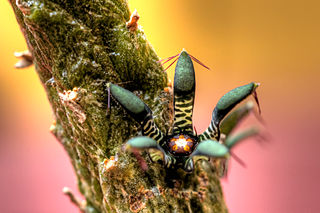
Rhytidocaulon is a plant genus in the family Apocynaceae, first described in 1962. It is native to northeastern Africa and the Arabian Peninsula
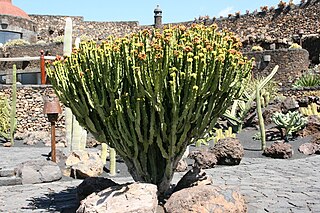
Euphorbia abyssinica, commonly known as the desert candle or candelabra spurge, is a species of plant in the family Euphorbiaceae. E. abyssinica is endemic to Ethiopia, Somalia, Sudan and Eritrea. It was first described in 1791, by the German botanist Johann Friedrich Gmelin. In its native habitat, it can grow up to 10 m (33 ft) tall. The woody stem is used for firewood and as timber in roofing, furniture and other items, and the sap is used in traditional medicine. It is also cultivated as an ornamental house plant.
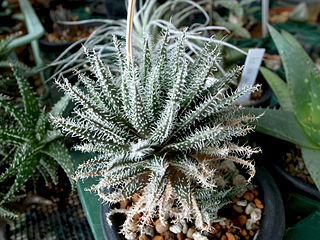
Aloe haworthioides is a species of plant in the genus Aloe native to Madagascar. This aloe is named for its leaves, which are covered with soft spines that create a resemblance to Haworthia species. A small species, it grows in stemless, clumping offsets and sports orange, highly fragrant flowers.

Haworthia lockwoodii is a species of succulent plant in the genus Haworthia. Native to the Cape Province of South Africa, it was named for a local magistrate.
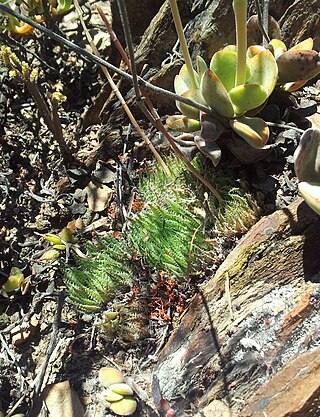
Haworthia herbacea is a species of succulent plant in the genus Haworthia native to the Cape Province of South Africa. Closely related to Haworthia reticulata, it has greenish yellow leaves with small spines. As it matures the leaves get darker green and the white spots raise. Flowers by way of a shoot and produces a large off-white flower.

Pseudolithos migiurtinus is a species of succulent plant in the genus Pseudolithos. Native to Somalia, it is akin to other species in the genus in that it grows in arid environments and is a small, leafless plant that looks somewhat like a stone, hence the name. It can range from green to ochre in color. This species is up to 120 millimetres (4.7 in) high and 65 millimetres (2.6 in) around, can be either cubiform or cylindrical in form, and may grow small branching columns in older plants.
Pseudolithos horwoodii is a species of succulent plant in the genus Pseudolithos. Native to arid areas of Somalia, it is a small, leafless plant up to 80 millimetres (3.1 in) tall and 45–60 millimetres (1.8–2.4 in) wide. Its growth habit is squat, unbranched, and blob-like, living up to the name of its genus which means "false stone". Its color is green to grayish brown.

Pseudolithos caput-viperae is a species of succulent plant in the genus Pseudolithos. It is a small, leafless plant up to 15–40 millimetres (0.59–1.57 in) tall and either green or brownish. First discovered and described in the 1970s by botanists John Jacob Lavranos and Renato Bavazzano, it is native to Somalia. The seedlings of the plant are identical to Pseudolithos migiurtinus, but start to branch after a year, making this the only member of Pseudolithos that is not just a single squat stem. Its Latin species name means "snake head".
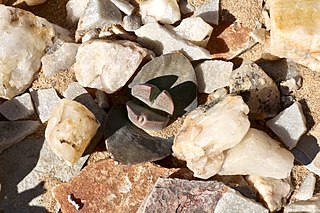
Cheiridopsis peculiaris is a species of succulent plant in the genus Cheiridopsis native to South Africa. Its name refers to the peculiar leaf shape compared to other species in its genus. Like other Cheiridopsis it has leaf pairs, but unusually the outer pair grows flat along the ground while the other pair faces toward the sky.
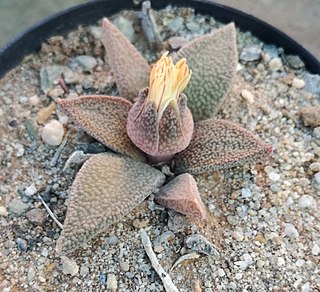
Aloinopsis rubrolineata is a species of succulent plant in the genus Aloinopsis native to South Africa. It grows in a branching habit low to the ground, and has leaves covered with small, round tubercles. The leaves are dark olive green and tongue-like in shape. Its scientific name refers to its flowers, which have a distinctive red stripe.

Dracaena hallii is a species of succulent plant native to Mozambique, Zimbabwe, and Limpopo Province of South Africa. The species was named for Harry Hall, formerly the curator of succulents at Kirstenbosch National Botanical Garden in Cape Town. Commonly known as the "baseball bat" plant, it has extremely thick foliage with a rounded shape and a central channel.

Dracaena ballyi is a species of succulent plant native to Kenya and Tanzania. It grows in small rosettes with leaves that have bands of color and sharp tips. Originally collected by Peter Bally in 1963 and long cultivated as a houseplant, it was scientifically described in 2004.

















